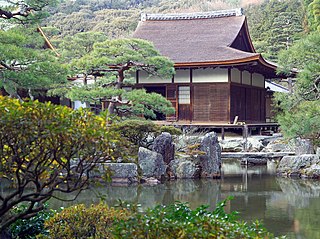
A forest is a large area of land dominated by trees. Hundreds of more precise definitions of forest are used throughout the world, incorporating factors such as tree density, tree height, land use, legal standing and ecological function. According to the widely used Food and Agriculture Organization definition, forests covered 4 billion hectares (9.9×109 acres) (15 million square miles) or approximately 30 percent of the world's land area in 2006.

In computer science, an abstract syntax tree (AST), or just syntax tree, is a tree representation of the abstract syntactic structure of source code written in a programming language. Each node of the tree denotes a construct occurring in the source code.
Infix notation is the notation commonly used in arithmetical and logical formulae and statements. It is characterized by the placement of operators between operands—"infixed operators"—such as the plus sign in 2 + 2.
Meronymy is a semantic relation specific to linguistics, distinct from the similar metonymy. A meronym denotes a constituent part of, or a member of something. That is,

A bungalow is a small house or cottage that is either single-storey or has a second storey built into a sloping roof, and may be surrounded by wide verandas.
This is a Family tree of the Kings of Navarre from Íñigo Arista until the accession of Henry III of Navarre to the throne of France.

Cleyera japonica (sakaki) is a flowering evergreen tree native to warm areas of Japan, Taiwan, China, Myanmar, Nepal, and northern India. It can reach a height of 10 m. The leaves are 6–10 cm long, smooth, oval, leathery, shiny and dark green above, yellowish-green below, with deep furrows for the leaf stem. The bark is dark reddish brown and smooth. The small, scented, cream-white flowers open in early summer, and are followed later by berries which start red and turn black when ripe. Sakaki is one of the common trees in the second layer of the evergreen oak forests. It is considered sacred to Japanese Shintō faith, and is one of the classical offerings at Shintō shrines.
In digital circuit design, register-transfer level (RTL) is a design abstraction which models a synchronous digital circuit in terms of the flow of digital signals (data) between hardware registers, and the logical operations performed on those signals.

Moon trees are trees grown from 500 seeds taken into orbit around the Moon by Stuart Roosa, the Command Module Pilot on the Apollo 14 mission in 1971. Roosa, who had been a smoke jumper, was contacted by Ed Cliff, the Chief of the Forest Service at the time, with the idea of taking the seeds along. Seeds for the experiment were chosen from five different species of trees: loblolly pine, sycamore, sweetgum, redwood, and Douglas fir.
A sister group or sister taxon is a phylogenetic term denoting the closest relative(s) of another given unit in an evolutionary tree.
Floruit, abbreviated fl., Latin for "they (sg.) flourished", denotes a date or period during which a person was known to have been alive or active. In English, the unabbreviated word may also be used as a noun indicating the time when someone flourished.

Qingdao railway station is a railway station in Qingdao, Shandong, in the People's Republic of China. In the years leading up to the 2008 Summer Olympics, the station underwent a significant renovation in order to accommodate increased passenger traffic for the Olympic period and afterwards. The new station is an example of German architectural traits incorporated into a Chinese-designed building, which is consistent with many structures in Qingdao.

Shoin-zukuri (書院造) is a style of Japanese residential architecture used in the mansions of the military, temple guest halls, and Zen abbot's quarters of the Azuchi–Momoyama (1568–1600) and Edo periods (1600–1868). It forms the basis of today's traditional-style Japanese house. Characteristics of the shoin-zukuri development were the incorporation of square posts and floors completely covered with tatami. The style takes its name from the shoin, a term that originally meant a study and a place for lectures on the sūtra within a temple, but which later came to mean just a drawing room or study.
In analogy to natural language, where a noun phrase refers to an object and a whole sentence refers to a fact, in mathematical logic, a term denotes a mathematical object and a formula denotes a mathematical fact. In particular, terms appear as components of a formula.
The family tree of the 25th Dynasty is too complex to show in its entirety and it is not always clear whether a pharaoh is a son or brother of his predecessor. The following is a simplified – yet updated to 2017 – version following the new dynastic arrangement which sees Shebitku as Shabaka's predecessor rather than successor as traditionally stated.
This is a family tree of the monarchs of the Kingdom of Aragon.
The family tree of the Castilian monarchs of the Kingdom of Castile (1065–1230), in the historical region of Castile in Spain.







